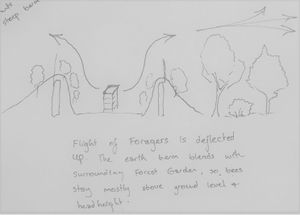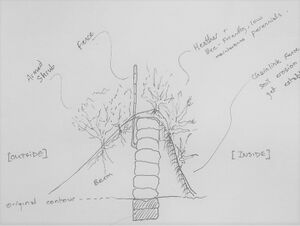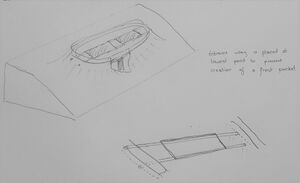
This article is a discussion about how beekeeping could best be integrated with forest gardening, mainly focusing on how to house the bees.
Should bees be kept in a Forest Garden?[edit | edit source]
Bees are very important for pollination, although there are many other species which act as insect pollinators. Without successful pollination, some plants will not fruit or produce a poor yield (e.g. fruit trees). By combining beekeeping with forest gardening, pollination is more reliable and yields can be maximized. This is particularly a consideration for the future, as wild populations of bees continually reduce. With the rich diversity of species and the different flowering times that come with it, the forest garden habitat provides bees with a steady supply of nectar and pollen for most of the year. A forest garden might be so appealing to bees that foragers from surrounding wild bee colonies will frequently visit. It is even possible that wild bees will sooner or later establish themselves within a forest garden, as was the reported experience of Maddy and Tim Harland in their forest garden.
However, beekeeping has disadvantages, the need for intensive and regular management to prevent swarming foremost. It is potentially not ideal if a bee swarm settles in an inconvenient place within the forest garden. Bees can also be aggressive, and since most forest gardens tend to be fairly small, potentially with objecting neighbors, this could be a problem. "Following" is a behavior of some bees where they follow and attack any human or animal who comes near their colony, sometimes for some distance. Colonies differ in their aggression levels, and this may not be an issue.
General considerations when designing apiary sites[edit | edit source]
According to Waring & Waring (2015),[1] the following are considerations in choosing where to site beehives:
- Shelter from strong winds. The hives should face away from prevailing winds so that returning foragers fly upwind, making maneuvering easier. In a sheltered site, hive entrance is best south facing. Thick hedges are ideal as a windbreak for an apiary site. The activity of insect pollinators is hampered by high winds.[2] European bees will not fly in windspeeds of 24 km/h, and flowers in sheltered location receive more bee visits than flowers in exposed sites.[2]The bees will not tend to be active during windy weather (also if it is too cold or wet).[1]Workers will not forage as much, and consequently the efficiency of pollination will decrease.
- Shaded in summer, but in sunlight during winter. Deciduous trees are suggested for this.
- Prevent animals from getting to the hives.
- Close to a water supply, but at least 6 m away from the hives.
- Consider keeping hives in a shed.
- Locate bees away from neighbors. Consider placing obstacles that cause bees to fly up and above head height to keep them out of peoples' way. Fine mesh or wire fences work as obstacles to bee flight paths, even if bees could easily fit through the apertures they prefer to fly over.
They advise that hives placed in the middle of a group of shrubs is ideal. Or at the edge of fields or woodland.
Further considerations could be added:
- Ensure plenty of bee-friendly plants are located in regions where you don't mind there being a lot of bees.
- Barriers could serve multiple functions, a hedge could have thorns to keep out animals, and at the same time act as windbreak and an obstacle to flight.
- Avoid siting or creating a frost pocket where the hives are to be located.
Suggested design to ideally site an apiary within a forest garden[edit | edit source]



For this design, it is assumed that humans including children, and domesticated animals such as dogs and cats have free roam of the forest garden, and potentially occasional larger wildlife such as deer.
A walled enclosure is created, the quickest and cheapest method might be an earthbag wall, earth bermed on both sides to prevent degradation of the wall under sunlight, and to add growing space. To maximize the space available inside the enclosure, the internal berm is steep. To hold the earth in place until plant roots get established and stabilize the slope, scrap lengths of chain link fence can be laid flat on the berm surface. A fence is placed along the crest of the wall. This acts as a barrier to animals and small children before plants get established.
The best plants for this internal berm surface could be low maintenance, perennial and bee-friendly, while providing some potential use to humans, e.g. lavender. The best plants for the external berm surface would ideally have similar characteristics, but also be armed with thorns and be of a more substantial size and density (while being deciduous to prevent too much winter shading). A combined hedge of species such as Gooseberry, Worcesterberry or Hawthorn might be suitable.
The chosen site could be on a slight slope, allowing any cold frosty air to escape out the entrance and prevent the creation of a frost pocket. Since bees perceive fine mesh to be a barrier, the lower part of the door could be constructed from mesh, or even the whole door. Ideally the entrance would not be facing the prevailing wind direction.
Vigas are placed on the crest of the wall, one can be set in a lower course of earthbags to create a monopitched roof. Rainwater can be harvested on this roof and used to supply a nearby pond for the bees water source, or to be a station to store water for watering plants. The roof is orientated such that the hives are shaded in the summer, but still catch some winter sun.
The floor of the enclosure is either a carpet of perennial (or self seeding) ground cover. Failing this, a zero maintenance floor such as gravel or paving slabs will prevent the need to weed or mow grass.
Nearby a small shed to house beekeeping veil, jacket, hive tool, spare hive components, and other equipment.
References[edit | edit source]
- ↑ 1.0 1.1 Waring, A; Waring, C (2015). Get started in beekeeping. Hodder & Stoughton. ISBN 9781473611832.
- ↑ 2.0 2.1 Roubik, DW (1992). Ecology and Natural History of Tropical Bees. Cambridge University Press. ISBN 9780521429092.